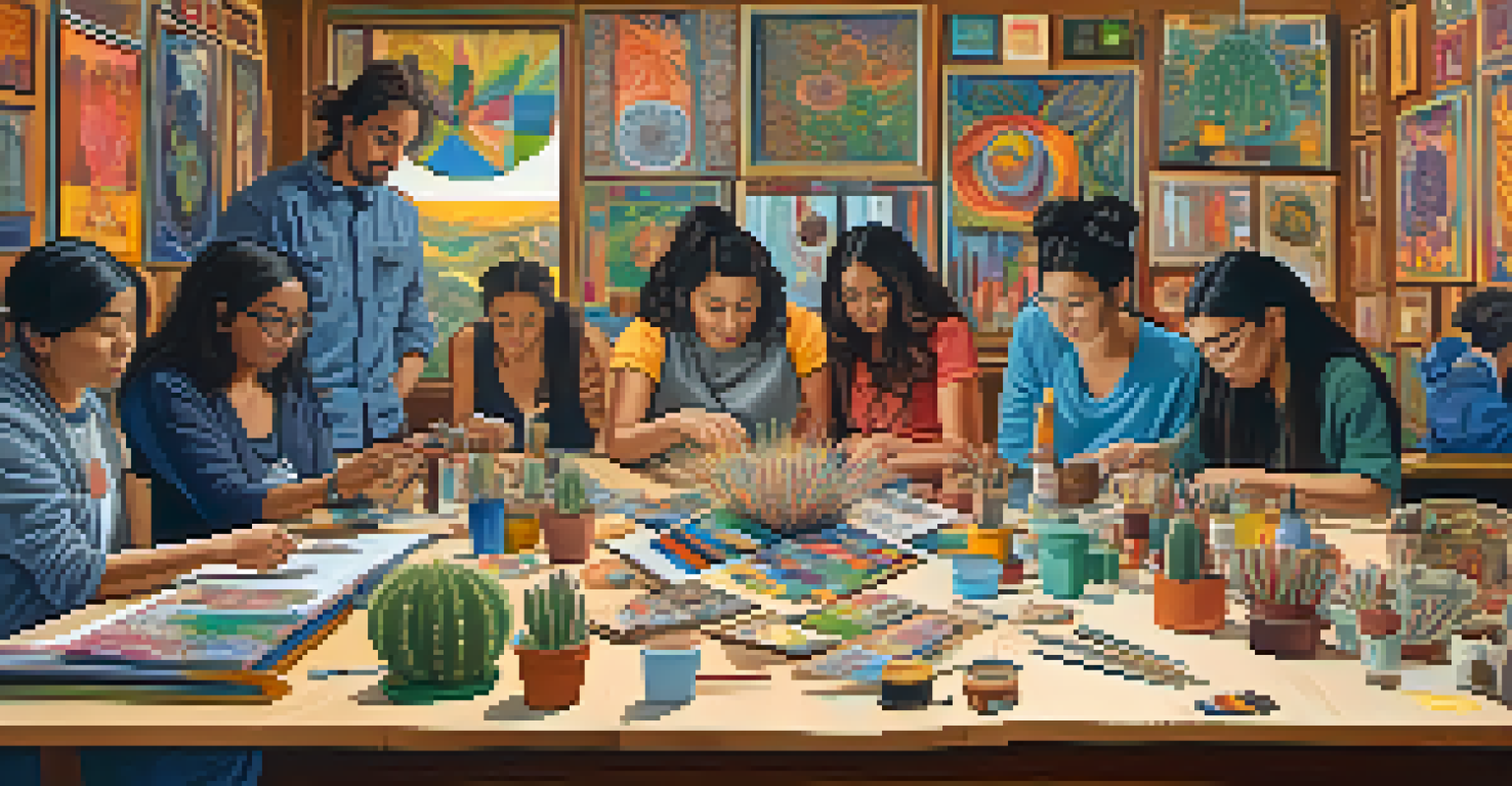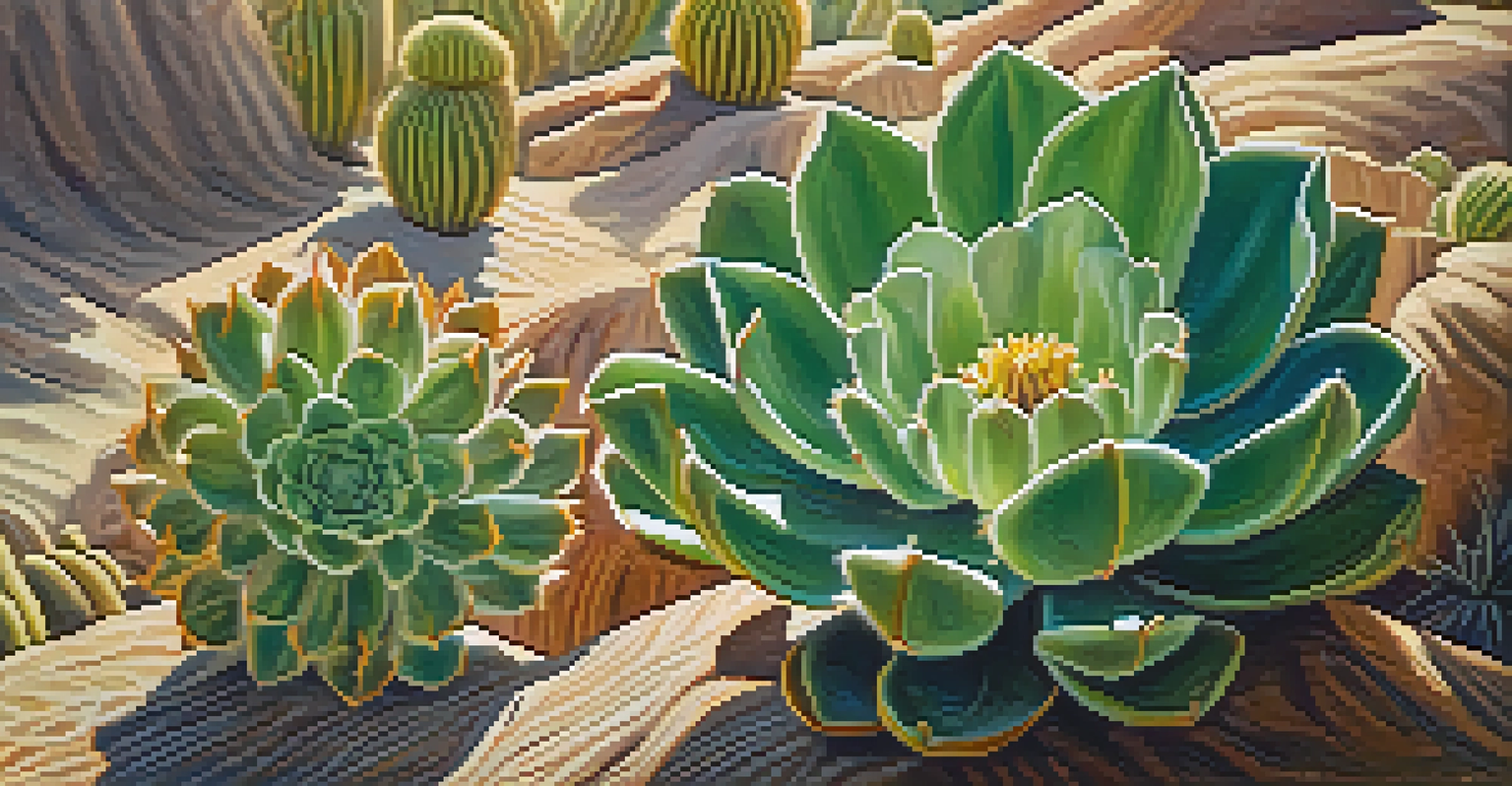Peyote-Induced Altered States and Their Creative Potentials

Understanding Peyote and Its Cultural Significance
Peyote, a small cactus native to North America, has been used for centuries by Indigenous cultures for spiritual purposes. It contains mescaline, a psychoactive compound that can induce altered states of consciousness. This unique plant is not just a hallucinogen; it's a profound symbol of cultural heritage, often employed in rituals to promote healing and introspection.
Psychedelics are a way of exploring consciousness and creativity that has been overlooked for far too long.
In these traditional contexts, peyote serves as a bridge between the physical and spiritual worlds. For many Indigenous peoples, the experiences it facilitates are deeply meaningful, fostering connections with ancestors and the universe. This rich history adds layers to our understanding of peyote beyond its recreational use, highlighting its role in fostering creativity through spiritual exploration.
As we delve into the creative potentials of peyote, it's essential to recognize its cultural roots. By appreciating the traditions surrounding this sacred plant, we can better understand how it may inspire artistic expression and innovation today.
The Science Behind Peyote's Psychoactive Effects
When ingested, peyote affects the brain's serotonin receptors, leading to changes in perception, mood, and cognition. This alteration can result in vivid visual and auditory hallucinations, which many users describe as an expansion of consciousness. The experience is often accompanied by a heightened sense of introspection and emotional clarity, creating fertile ground for creative thinking.

Research has shown that psychedelics like peyote can enhance divergent thinking, a key component of the creative process. Divergent thinking involves generating multiple solutions to a problem, allowing for innovation and originality. This ability to think outside the box can be particularly beneficial for artists, writers, and musicians seeking new inspiration.
Peyote's Cultural Heritage Matters
Peyote is not just a psychoactive substance; it holds deep spiritual significance for Indigenous cultures, serving as a bridge between the physical and spiritual worlds.
Understanding the science of peyote's effects provides insight into why many creatives turn to it for inspiration. The altered states induced by peyote can lead to breakthroughs in artistic expression, enabling individuals to tap into deeper layers of their imagination.
Personal Experiences: Artists and Peyote
Many artists have shared their transformative experiences with peyote, often describing moments of profound clarity and inspiration. For instance, some musicians report that peyote enhances their ability to connect with their inner voice, resulting in compositions that resonate deeply with both themselves and their audiences. These narratives highlight the intersection of peyote use and artistic creation.
The experience of peyote is one of connection, both to the cosmos and to our deeper selves.
Visual artists, too, have found that peyote can unlock new dimensions of perception. They describe how the altered state allows them to see colors, shapes, and patterns in ways that feel almost otherworldly. This heightened sensitivity can lead to innovative techniques and styles that set their work apart from the mainstream.
These personal experiences underscore the potential of peyote as a catalyst for creativity. By exploring the profound connections between altered states and artistic expression, we can appreciate how peyote may serve not just as a substance, but as a muse.
Navigating the Risks of Peyote Use
While peyote can offer creative insights, it's crucial to approach its use with caution. The effects can be unpredictable, varying significantly from person to person. Factors such as individual mental health, setting, and dosage all play a role in shaping the experience, making it essential to prioritize safety and mindfulness.
Additionally, the legality of peyote varies widely, with restrictions in many regions. Understanding the legal implications is vital for those considering its use. Engaging with peyote in a responsible manner means respecting both the law and the cultural practices surrounding it.
Psychedelics Boost Creative Thinking
Research indicates that peyote can enhance divergent thinking, allowing artists and creators to explore new ideas and artistic expressions.
By acknowledging the risks and responsibilities associated with peyote, we can foster a more informed dialogue about its potential benefits. A balanced approach encourages a safe exploration of creativity while honoring the traditions that have long revered this sacred plant.
Altered States and the Creative Process
Altered states of consciousness, whether induced by peyote or other means, can profoundly impact the creative process. When our usual mental patterns are disrupted, we open ourselves to new ideas and perspectives. This can lead to unexpected solutions and innovative approaches in artistic endeavors.
Consider how many great works of art, literature, and music have emerged from moments of altered perception. The surrealists, for instance, often sought to tap into dreams and subconscious thoughts to fuel their creativity. Peyote can serve a similar purpose, allowing individuals to access deeper layers of their psyche.
Ultimately, the relationship between altered states and creativity is complex and deeply personal. For many, peyote acts as a tool to unlock their creative potential, but it's just one of many pathways to inspiration.
Cultural Appropriation vs. Appreciation
As interest in peyote and other psychedelics grows, discussions around cultural appropriation become increasingly relevant. It's important to approach the use of peyote with respect for its origins and the communities that have historically utilized it. This means acknowledging the spiritual and cultural significance of the cactus rather than treating it solely as a recreational substance.
Appreciation involves understanding the context in which peyote is used and engaging with Indigenous communities in a respectful manner. Many advocates encourage learning from these cultures rather than appropriating their practices. This mindset fosters a more ethical relationship with peyote and its creative potentials.
Respect Cultural Context of Peyote
Engaging with peyote requires understanding its cultural roots and practicing respect for the Indigenous communities that have long revered this sacred plant.
By committing to cultural sensitivity, individuals can enjoy the benefits of peyote while honoring the traditions that have safeguarded its use for generations. This approach not only enriches personal experiences but also contributes positively to a broader conversation about the intersection of culture and creativity.
Future Research on Peyote and Creativity
The burgeoning interest in psychedelics has sparked a wave of research exploring their effects on creativity and mental health. Studies examining peyote's potential benefits are still in their infancy, but early findings suggest promising avenues for further exploration. Understanding how peyote influences creative processes could lead to new therapeutic approaches for artists and non-artists alike.
Moreover, as the stigma surrounding psychedelics dissipates, we may see a shift in how they are integrated into creative practices. Workshops and retreats that focus on peyote as a tool for inspiration are emerging, offering safe environments for exploration. These settings can provide valuable insights into the relationship between altered states and creativity.

As research progresses, we may uncover more about the mechanisms through which peyote enhances creative expression. This knowledge could not only benefit artists but also inform broader conversations about mental health, creativity, and the human experience.